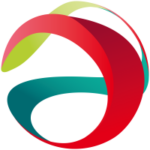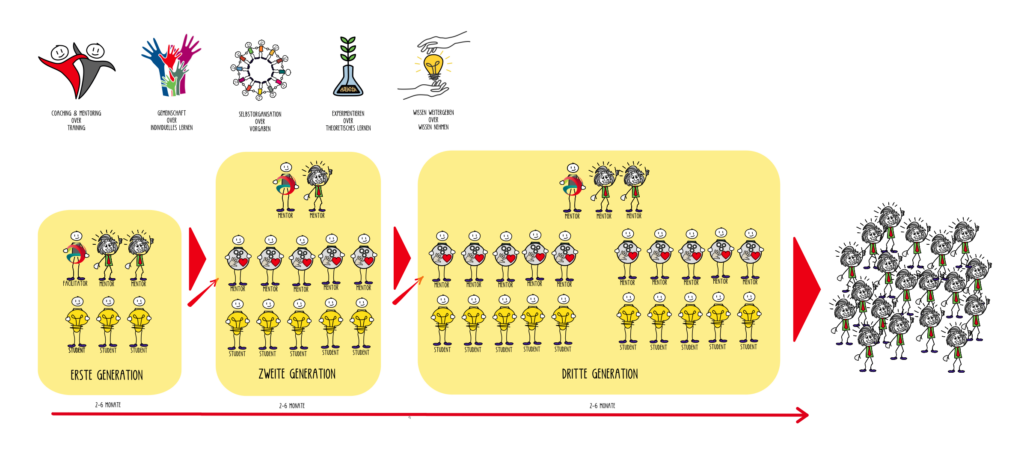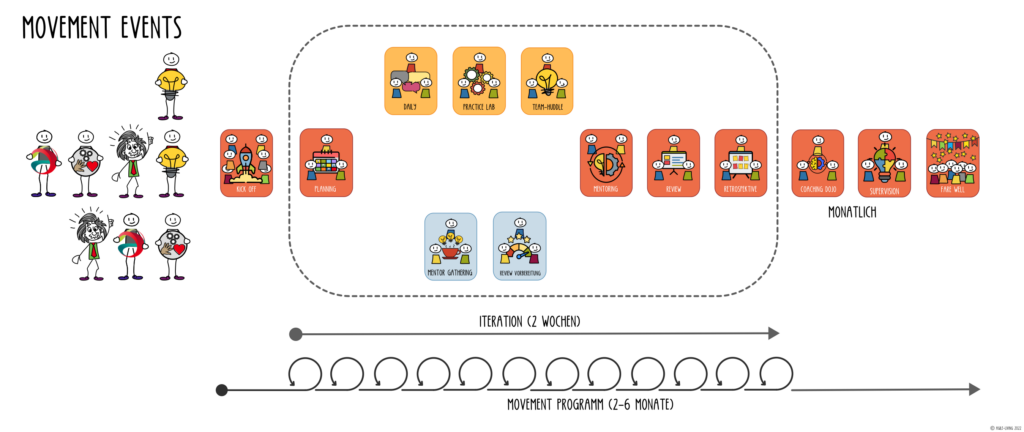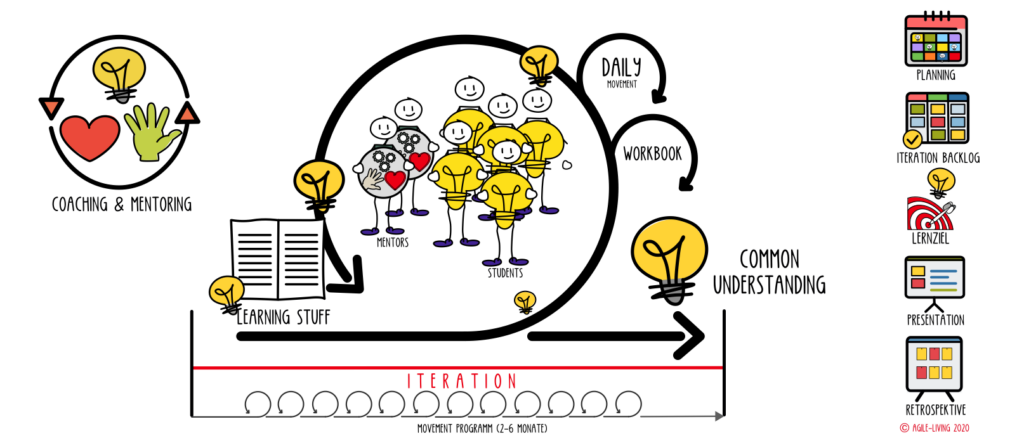
The Movement Guide
New Learning with Coaching & Mentoring

Purpose
We developed the Movement in 2019 and now want to write a Movement Guide to help people sustainably embed the processes and practices necessary to achieve the change they want.
The Movement Guide describes the definition of the Movement. Each element of the framework serves a specific purpose that is essential to the overall value and success of the Movement. Changing the core design or ideas of the Movement, omitting elements, or failing to follow the Movement rules forfeits opportunities for effectiveness, limits the usefulness of the Movement, and may even render it worthless.
For many years, we have been helping companies better manage the increasing complexity in the world using Scrum and other agile frameworks. In doing so, we have witnessed the difficulties of implementing and executing transformations, and the significant challenges of embedding the necessary knowledge and support into the organization in a sustainable way.
We are happy to report that the Movement is already being used successfully in various areas where a common understanding of working methods and knowledge needs to be developed and made available to many people in a sustainable way.
It has turned out that a Movement is not only used to set up agile frameworks in a more stable way and to accompany them up to the certification of the participants, but is also suitable for any knowledge transfer that needs collaboration, self-organization and common understanding. It can be used for Scrum roles, leadership development, specialized knowledge such as software architecture, DevOps to the development of sustainable communication, conflict resolution and when used for specialist careers.
In the application of the Movement, patterns, processes and insights are used that have also already proven themselves in the use of Scrum. Thus, all the desired learning content can be developed in a self-organized manner and scaled across the entire enterprise.
In addition, the interaction of the elements in the Movement prepares the ground for the professional and personal development of all participants.
The Movement has already proven itself many times in the introduction and establishment of Scrum in the company.
Movement Learning
New Learning places individual development and initiative at the heart of learning. This approach emphasizes the importance of holistic learning, which not only aims to build skills but also focuses on personal development. It is a process that puts the learner at the center by encouraging self-direction and initiative, covering a wide range of skills from technical expertise to emotional intelligence.
Agile learning expands this perspective through a structured, iterative approach that supports self-organization and strengthens the practical application in everyday professional life through regular feedback and reflection cycles. This method facilitates continuous adaptation and improvement by encouraging learners to critically reflect on their progress and learn from their experiences.
Social learning, on the other hand, emphasizes the importance of collaborative learning. By sharing knowledge and fostering collective skills within a group or community, this approach supports a deep and multi-layered learning experience. It demonstrates how collective intelligence and collaboration have the potential to enrich and extend individual learning.
These different approaches to learning reflect the multiple ways in which people learn throughout their lives – from family and peer groups, to school and further education institutions. While traditionally the focus has often been on individual learning and personal self-organization, in today’s world of work, which increasingly demands teamwork and collaborative skills, shared learning goals are becoming more important. The challenge is to balance individual needs with the demands of the group, which requires openness and discipline – skills that can be overwhelming for many people and organizations.
Movement-Learning
The concept of movement learning provides an innovative solution to this challenge. It combines individual and collective learning processes through self-directed learning in small groups that work on learning content tailored to the respective level of knowledge of the participants. Participants tackle real-life tasks that are applied directly in an everyday context, supported by regular feedback from mentors and experts. Personal growth is also encouraged through 1:1 mentoring, with particular attention paid to individual needs and goals.
Movement learning emphasizes the importance of collective skill building and individual advancement by creating a balance between self-organized learning within a structured environment and leveraging group diversity to foster collaboration. This approach not only strengthens learning within organizations, but also ensures that valuable knowledge is not lost when individuals leave. It is a sustainable approach that sets the course for a future-oriented learning culture.
Movement structure
The Movement Framework came about because we, as Agile Coaches, experienced how difficult it is to create a desired change in a sustainable way. Inspired by Derek Sivers‘ TED Talk, we decided to use the phenomena of an emerging Movement to proactively shape change.
The Movement is based on the assumption that any desired change, up to and including transformation, needs everyone involved and affected in order to shape and sustain the change. The point is that a desired change can be initiated by individuals but needs everyone to make it successful. A Movement empowers employees to develop a common understanding of the desired change and to carry this into the company as multipliers, to bring others along and to anchor it sustainably.
There are already many helpful approaches that can help to better deal with the ever faster changing and ever more complex world in order to solve the challenges of tomorrow.
At the same time, we can observe that many companies have great difficulties in effectively anchoring these approaches in the company in the long term. Many companies struggle with resistance to change, culture clashes, and lack of consistency in processes and practices. [Agile Status Report]
The Movement relies on guided and self-organized learning in groups where participants build a common understanding, test it in their daily work, reflect on it with mentors and specialists, adapt it and develop it further.
The Movement focuses on incremental and scalable change, where employees themselves bring the desired message to life, support each other and thus shape the cultural change themselves.
The Movement combines four pillars for sustainable learning. Self-organized learning communities that collaboratively acquire the required knowledge themselves. Professional and personal support through mentoring. A constantly repeating loop of learning, implementing, reflecting and adapting, over a period of 5-6 months. Scalable sustainability through the progression of participants into the next mentors.
Self organized learning groups
Most work today takes place in teams. And these teams have to find out which working methods, which knowledge they need in order to fulfill their tasks together.
The participants of a Movement develop new knowledge together in a self-organized way and learn to deal with group dynamics and resistance. They try out new processes and practices, reflect and become the support for each other that they need for change.
Coaching & Mentoring
Companies often bring in specialists to solve specific problems. When these specialists leave the company again, the problems often arise anew.
The Movement relies on using the knowledge of specialists to pass on their knowledge. All participants are accompanied with 1:1 mentoring and can develop professionally and personally. This leads to a sustainable anchoring of new skills.
In-service learning
Learning takes time. All learning needs understanding, applying, reflecting and adapting until at some point we are so good at it and can derive and develop completely new ideas from our skills.
In a training session we can build understanding, but in everyday work the trainer is no longer there to reflect with us on the successes and failures of our initial implementation steps and to guide us in making the necessary adjustments.
Movement offers the opportunity to immediately try out what we have learned in the work context and then reflect on it with the learning community and mentors. This creates learning loops that produce results that can stand the test of time in everyday work.
Scaling & Consistency
For the change in our world and the companies, not only individual specialists can bring about the change. We need all employees in the companies to implement the desired change. Therefore, we need an environment in which employees not only learn for themselves and their tasks, but pass on the knowledge to many others so that we as a community can manage the change.
The Movement makes it possible to acquire the necessary knowledge as a student and then mentor future learning groups yourself. This is the basis for scaling the knowledge and skills in the organization. The specialists are no longer the limiting factors, but support that many other colleagues, can apply and pass on the knowledge.
Movement Manifesto

Coaching & Mentoring over Training
Collaborative learning over individual learning
Self-organization over guidelines
Experimentation over Theoretical Learning
Sharing knowledge over Taking knowledge
Roles
Students
Students are the participants in a Movement-Generation who work through the learning objectives in a small group of 3-5 participants.
This group size allows a good balance for learning and work ability. Group dynamic effects can only be experienced with at least 3 participants. If the group becomes larger, the self-organization of the participants becomes increasingly difficult and group learning suffers.
The students are responsible for
- The self-organized processing of the Learning Objectives
- Ensuring that the group as a whole has understood all the learning content
- Keeping the Student Workbook
- Participating in the Movement Events
- Coordinating the deadlines
- The moderation of their reviews
Movement Mentor
A Movement Mentor already has a lot of experience in his or her field and can accompany Movement Students on their Movement journey with professional and personal support.
At the start of a movement in a company, the learning objectives and the framework are still unfamiliar to the mentors. Here, support from the facilitator is needed so that the mentors grow into their roles.
In order for the Movement to grow throughout the entire organization, i.e. new Movements are started one after the other, Movement graduates can provide support as mentors in a subsequent Movement.
They receive support from other experienced mentors or the Movement Facilitator.
A mentor is responsible for
- Accompanying a student
- Attending relevant Movement events
- Working with one’s own mentor (at least the first time)
- Working with the other mentors in the Movement.
- The facilitation of student retrospectives
- The preparation and implementation of professional dojos
- The own personal growth (supervision & coaching dojo).
Movement Facilitator
A Movement Facilitator knows the Movement Framework, the specific topics for being a mentor and can facilitate all necessary events. This includes info events, kick-off, the Movement Events and a Farewell.
The knowledge of a facilitator enables to build up a Movement structure in a company. The facilitator accompanies the 1st generation mentors as a mentor.
The Movement Facilitator does not need to have expertise in content. The Facilitator can be a mentor to a novice mentor given experience, as this area is usually more about personal growth.
The Movement Facilitator is responsible for
- Introducing the Movement Framework to the organization
- Adherence to the Movement Framework
- Mentoring the first mentors
- Facilitating the Movement events
- Implementation of Kick-Off and Farewell
Specialists
Subject specialists develop the learning content and build up the knowledge according to taxonomy levels. In this way, programs can be developed that build on each other and can be used for specialist careers and certifications.
A subject matter expert is responsible for
- the delivery of the learning content
- Collaborating with the movement facilitator and mentors
- Use of the coaching session to guide the students
- Clarification of the framework and guidance for certification in his or her area of expertise
Events

the Movement
The Movement is the container for the entire learning cycle of one or more learning groups.
The Movement starts with a Kick-Off and ends with a Farewell.
The time investment for a Movement program is 12 iterations of 2 weeks each.
Participants of the Movement are students, mentors, facilitator and if necessary a certification coach.
The facilitator can support with the preparation. This involves
- the information event
- Kick-off
- Provision of the Learning Objectives
- Provision of the Student Workbooks
- Preparation for the timed events
- The events described below are the activities in a Movement.
At the end of a Movement program, all Learning Objectives are developed, Student Workbooks are completed and reflected upon, visible community activities take place, and participants are certified, if applicable.
Iteration

A Movement iteration lasts 2 weeks. During this time, the students and mentors use the events to present the results of the learning objectives at the end of the iteration.
Planning
In Planning, the students of a Movement program discuss which Learning Objectives will be worked on together in the next iteration. They coordinate their schedules and how they can come to a group-wide understanding of the learning content.
Planning takes place for 30-60 minutes at the start of each iteration.
Participants are the students of a Movement program and at least one mentor.
Planning is based on the Learning Objectives.
In Planning, students choose the next Learning Objectives in a self-organized way and discuss their collaboration.
The mentor(s) answer questions.
At the end of the planning, the students have a common understanding of what they want to achieve in the next iteration and how they will shape their collaboration.
Daily
In the Daily, students discuss upcoming activities, review Learning Objectives, and ensure learning transfer within their Movement group.
A Daily takes place daily for 15 minutes.
Participants are the students of a Movement program. A mentor can be added if desired.
The overview of the Learning Objectives is the basis for the discussions.
Students discuss current status, schedule meetings, support each other with questions, clarify transfer issues, and discuss day-to-day challenges.
The desired outcome of a daily is sharing, fostering group cohesion, clarity and reliability for shared learning, collaboration and support.
Team Huddle
The Team Huddle is the time period when students work together on the Learning Objectives and share experiences.
It is scheduled 1 hour per week.
Participants are the students and, upon request, a mentor.
Team Huddle is about collaborative work on the Learning Objectives and self-organized use of shared time for the common group outcome.
Team Huddle is where the results on the Learning Objectives and the transfer of learning to the group occur.
Practice Lab
The Practice Lab is about practicing new practices and feedback in a protected space-.
1 hour is scheduled per iteration.
Participants are the students and on request also a mentor.
Prerequisites for the success of a Practice Lab is a good understanding of the practice being tested. The person presenting determines what specifically they would like feedback on.
The students discuss which practice is to be practiced and on which feedback is desired. After the practice, feedback is given as discussed.
Participants move on to new topics with initial experience, which they can then apply to their team. The Practice Lab strengthens the learning community, the learning from and with each other and trains the exchange of feedback.
Review
In the review, the learning outcomes of the current iteration are presented and the students receive feedback from the mentors and, if applicable, the certification coach.
In many areas, mentors are encouraged to give students as little guidance as possible so that they can experience the freedom and necessity of self-organization. In review, however, the goal is clarity on learning outcomes. For this reason, mentors are encouraged to provide clear and constructive feedback and responses.
1-2 hours per iteration are used for a review.
Participants in a review are the students, mentors, and certification coach, if applicable. Guests may be invited, but will only be included if requested by the Students.
In order for the review to be successful, the Learning Objectives must have been worked on. Mentors are able to provide constructive and substantive feedback.
The students can invite guests.
In the review, the students themselves lead through the review and present their learning outcomes. They are responsible for time management of the event. The mentors provide feedback on the content and the quality of the results. In addition, they offer questions and support for the transfer into the daily work routine.
After the review, students have a shared understanding of the learning content presented. The mentors can better assess the status of the learning group.
Retrospective
In the retrospective, students discuss how the learning and collaboration they designed worked and how they can improve it.
A retrospective is scheduled for 1.5 hours per iteration.
The retrospective is facilitated by a mentor from the specific Movement program for the Students. Students bring their topics.
A mentor prepares the retrospective format with which to guide the Students.
At the end of a retrospective, ideas and plans have developed that contribute to the improvement of the cooperation, the common group success. Group dynamic processes have been clarified. The students have results to the results they have brought in.
Student-Mentor Session (Mentoring)
1:1 mentoring provides students with professional and personal support. The focus is on learning content, challenges and transferring what has been learned into everyday work.
The time investment is 1-2 hours per iteration.
Participants are 1 student and the mentor chosen by the student in the kick-off.
The student prepares for the session using the Student Workbook. The student brings the relevant topics and considers what outcome the session should end with.
The student-mentor dialogue is designed by the student and mentor together. The activity is based on the topics and the desired goal – and ultimately on the mentor’s skills and experience.
Possible activities of the mentor can be: coaching, mentoring, sparring partner, consultant or trainer.
The result is based on the wishes of the participants: Answers, feedback, corrections, change of perspective and, if necessary, tasks and experiments for the student.
Coaching Session
The coaching sessions are primarily used to deepen and network what has been learned. The sessions are used by the certification coach, if necessary, to ensure quality for certification. Mentors receive an assessment of the student’s learning.
If there are 5-6 topics, there is a 1.5-2 hour coaching session for each topic.
Participants are the students, mentors, facilitator and certification coach if applicable.
The facilitator or certification coach prepares the sessions. Students have already developed all Learning Objectives related to the topic area.
The activities and tasks correspond to the prepared format. The focus is on interactive collaboration (students and mentors mixed), sharing, debrief and feedback.
The coaching session helps to clarify contexts. Ideas are developed for transferring what has been learned into everyday life and promotes common understanding.
Supervision
The format of collegial supervision is used for the participants to support each other with challenges in everyday life and personal problems. Here, one participant brings in a case that the other participants work on as consultants.
A supervision session lasts 2 hours and takes place every 4 weeks.
Supervision is available to all students and mentors as a support framework. It is accompanied and facilitated by the Facilitator.
The facilitator prepares the format and describes the process.
In the session, the supervision is conducted according to predefined format. Participants contribute according to their role in the supervision.
With some experience, students or mentors can also lead through the format.
Supervision will contribute to new perspectives for the caseworker. The community is strengthened and supports each other.
Dojos
Dojos are used to practice certain skills in depth. Well-known formats are, for example, Coaching Dojo and Coding Dojo.
The principle can be transferred to other topics.
A dojo is limited to a maximum of 2 hours and takes place once per iteration.
Participants are students and experienced mentors, facilitators or coaches.
Coaching Dojo is recommended for all mentors and managers (disciplinary and lateral).
Experienced mentors or coaches prepare the exercises.
Activities align with the format.
Participants have worked on an issue in depth.
Mentor Gathering
Mentor Gatherings are used for mentors to share the current status of students.In addition, mentors can use the time to grow as mentors.
Mentors invest 1.5 hours per iteration for their collaboration
Participants are the mentors, facilitator, and certification coach if applicable
The Gathering is conducted in a Lean Café format and can be led by the mentors themselves.
Possible outcomes of the event are answers to questions, options for action, and shared understanding of the state of the Students
Mentor-2-Mentor Session
The Movement is a coaching & mentoring program that enables scaled learning in the company.
For this reason, in addition to experienced mentors and, if applicable, certified mentors, former students can also develop into mentors for a Movement that they themselves have gone through as participants.
For those new to mentoring and if desired, mentors themselves can experience regular mentoring to grow into the new role.
Mentoring sessions last 1-2 hours per iteration.
Participants include a student-mentor and the mentor-mentor chosen at the kick-off.
The student-mentors bring their challenges to the session.
Session activities are aligned with the topics and desired outcome.
Possible outcomes are answered questions, feedback, and personal growth.
Artefacts
Learning Objectives
The learning content of a Movement is offered in the form of Learning Objectives.
These contents are prepared in a form that takes into account the students‘ level of knowledge and, based on Bloom’s Taxonomy, the cognitive learning process.
The Learning Objectives are developed by subject matter experts and/or the Certification Coach together with the Movement Facilitator.
Blooms Taxonomy
The learning is based on the level of knowledge of the participants.
For this reason, the Learning Objectives are developed according to the guidelines of Bloom’s Taxonomy.
Student Workbook
The Students Workbook is an accompanying documentation that a student keeps regularly over the period of the Movement.
This is used for reflection on what has been learned and for discussions in the student-mentor dialogue.
Learning Results
Die Ergebnisse aus der Bearbeitung der Learning Objectives sind die Grundlage der gemeinsamen Community-Arbeit und für den Wissenstransfer.
Die Ergebnisse werden mit den Movement Mentoren und ggf. dem Zertifzierung Coach reflektiert und besprochen.
End Note
The Movement is free of charge and is offered in this guide. The Movement framework as described here is immutable. It is possible to implement only parts of it, but the result is not the Movement. The Movement exists only in its entirety and works well as a container for learning many techniques, methods and practices.
Acknowledgement
In addition to the many people who have participated and contributed to the Movements so far, we would like to mention the initiators of the Movements who were instrumental in the initial phases: Bettina Ruggeri, Sven Schnee and Peter Müller. Many others like Olaf Lewitz, Björn Jensen, Holger Lotter and more contributed since then, and without their help the Movement would not have been refined as it is today.
Share-Alike license
© 2022 Bettina Ruggeri, Sven Schnee, Peter Müller
This publication is offered for license under the Attribution Share-Alike license of Creative Commons, accessible at https://creativecommons.org/licenses/by-sa/4.0/legalcode and also described in summary form at https://creativecommons.org/licenses/by-sa/4.0/. By utilizing this Movement Guide, you acknowledge and agree that you have read and agree to be bound by the terms of the Attribution Share-Alike license of Creative Commons.